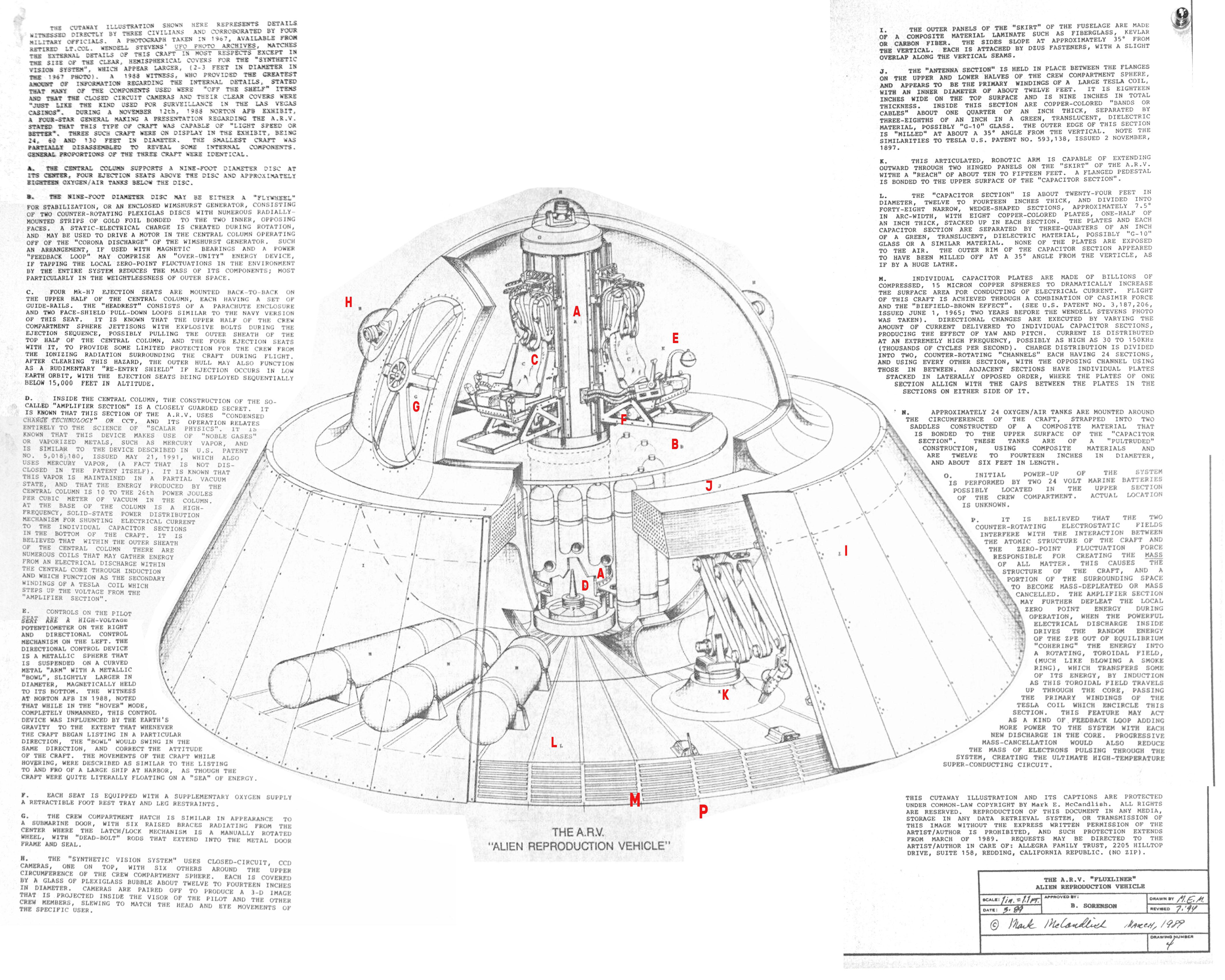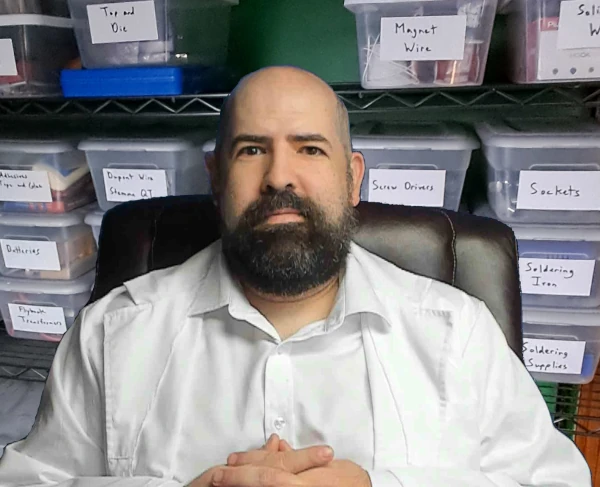04/27/2024 – APEC Open MIC
I hypothesize that the Biefeld-Brown effect is a result of unpaired nucleon spin alignment and is the propulsion method of the leaked “Alien Reproduction Vehicle”.
I will start with the origin of unpaired particle spin alignment.
- Magnetism was discovered in the ancient world but in time it was discovered unpaired electron spin alignment results in paramagnetism or ferromagnetism depending on the materials used such as Aluminum versus Iron.
- In 1915, the Barnett effect, discovered by Samuel Barnett, discovered that magnetization of an Iron bar occurs when it is rotated at high speed proving unpaired particle alignment can occur due to high speed rotation of materials with unpaired particles, in this case electrons.
- In 1971, GE Aerospace engineer Henry William Wallace is the first scientist to discover that rotation of materials made of unpaired nucleons, in his case Brass, generates a field that is not magnetic in nature and does not interact with magnetic fields. Wallace discovered that polarized unpaired nucleons caused nearby unpolarized unpaired nucleons to polarize as well.
- Brass
- 100% of Copper isotopes have an unpaired proton.
- 4% of Zinc isotopes have an unpaired neutron.
- Brass
- In 1992, Eugene Podkletnov built on the work of Wallace with a rotating YBCO superconducting disc that created a field lowering the weight of the disc.
- YBCO
- 100% of Yttrium isotopes have an unpaired proton.
- 17.5% of Barium isotopes have an unpaired neutron.
- 100% of Copper isotopes have an unpaired proton.
- <1% of Oxygen isotopes have an unpaired neutron.
- YBCO
- In 2020, Eugene Podkletnov continued building on his work with a rotating gold plated aluminum disc rotated between 8000-12000rpm and generated attractive and repulsive fields depending on the configuration of the disc.
- Second Podkletnov Disc
- 100% of Gold isotopes have an unpaired proton.
- 100% of Aluminum isotopes have an unpaired proton.
- Second Podkletnov Disc
- In 2021, R.H. Eskridge directed a research proposal and paper for NASA named “A Study of the Pope-Osborne Angular Momentum Synthesis Theory (POAMS) Including a Mathematical Reformulation and Validation Experiment”. In it they rotated a disc of Bismuth and it lost and gained an identical amount of weight depending on being rotated clockwise or counterclockwise. His team proved there is a polarity to rotationally induced nucleon spin alignment.
- POAMS Disc
- 100% of Bismuth isotopes have an unpaired proton.
- POAMS Disc
Now I will discuss relevant Biefeld-Brown effect experiments
- The Biefeld-Brown effect was first discovered by Thomas Townsend Brown back in the 1920s. Essentially when a parallel plate capacitor is charged the capacitor will move in the direction of the negative plate towards the positive plate.
- In 1928 and 1929, Brown published a patent “A Method of and an Apparatus or Machine for Producing Force or Motion” and an article in the magazine Science and Invention called “How I Control Gravitation”. In the article he described a capacitor device he had created with two 44lbs lead spheres as the positive and negative electrode and a glass rod dielectric separating the spheres. He claimed to have motion in the direction from negative to positive electrode when 120kV DC was applied over the course of five seconds, the capacitor was then stationary for between 30-80 seconds, and then finally returned to its original position where it would not move for around 5 minutes as it needed to ‘rest’. While many believe the BB effect is nothing more than ion wind due to the prevalence of lifters in the literature, an extremely high volume of wind would be needed to move 88lbs of lead. Ion wind is an unlikely explanation for this specific experiment.
- Lead Sphere Capacitor
- 22% of Lead isotopes have an unpaired neutron.
- Lead Sphere Capacitor
- In 1953, Thomas Townsend Brown wrote up a research proposal for the Navy called “Project Winterhaven”. The proposal was for a Mach 3 interceptor aircraft with the disc being energized to 5,000 kV. The proposal was for a five to ten year research and development program beginning with 2 foot diameter discs energized to 50 kV, 4 foot diameter discs energized to 150 kV and a 10 foot diameter disc energized to 500 kV. Brown hypothesized the creation of a device he called a “flame-jet” generator. It was essentially a jet engine that electrified its exhaust stream in order to create extremely high voltages. He also proposed using Barium Titanate on the skin of the craft due to its high dielectric constant.
- In 1957, Thomas Townsend Brown collaborated with the French company SUD AVIATION on “Project Montgolfier”. In communication with the company Brown stated that dynamic applications of the BB effect had been classified by the U.S. government. Dynamic applications could refer to propulsion systems and/or the use of pulsed voltages rather than static ones in capacitor experiments.
- In 1991, Robert Talley funded by the Air Force conducted experiments at 19kV on capacitors with an acrylic dielectric and PZT dielectric. Talley measured no movement with the acrylic capacitor until he used pulsed voltages and even then only at the highest pulse rate of 600 Hz. Talley measured multiple movements of the PZT dielectric as the current pulsed through the dielectric several times a second as its dielectric strength was not enough to prevent breakdown.
- Acrylic
- <1% of Carbon isotopes have an unpaired neutron.
- <1% of Oxygen isotopes have an unpaired neutron.
- >99% of Hydrogen isotopes have an unpaired proton.
- PZT
- 22% of Lead isotopes have an unpaired neutron.
- 11% of Zirconium isotopes have an unpaired neutron.
- 12% of Titanium isotopes have an unpaired neutron.
- <1% of Oxygen isotopes have an unpaired neutron.
- Acrylic
- In 2008, Takaaki Musha described an experiment by the Honda R&D Institute with a capacitor with two different applied voltages. One voltage was static DC at 18kV while the other was pulsed DC at 8kV and 50Hz. The pulsed DC capacitor experienced more weight loss despite half the voltage being applied in the experiment indicating pulsed voltages have higher propulsive capabilities than static ones.
A Government UFO That Ties Together Unpaired Nucleon Spin Alignment with the Biefeld-Brown Effect

- In 1988, Brad Sorenson according to Mark McCandlish OR Leonardo Sanderson according to Gordon Novel, leaked to his friend Mark McCandlish and Gordon Novel the existence of the “Alien Reproduction Vehicle” he reportedly saw at an air show thanks to being an aide for a prominent DoD official. The presentation was for politicians and bureaucrats with a ‘need to know’ in an effort to get their support for funding the production of a series of ARVs for the military. There were three models of the ARV all with the same outer appearance but in three different sizes.
- A general giving the presentation on the craft stated it was capable of light speed or better. It is unclear if that was relegated only to the largest model. According to Novel, he also stated that a state change occurred in the ARV when voltages of 1.2MV were used. No explanation of what happened with this state change was given.
- A side panel on the ARV was open to give the audience a look inside the craft. At the bottom of the craft there were what looked like four layers of parallel plate capacitors. The capacitors did not use thin flat metal electrodes as would be expected if the Biefeld-Brown effect was solely due to the energy stored in the capacitor. Instead the electrodes in the ARV’s capacitors were half inch thick and appeared to be copper.
My hypothesis
- Parallel plate capacitors put stress on the dielectric between the electrodes causing atoms and molecules to turn into electric dipoles with the electron clouds being pulled toward the positively charged plate and the nuclei being pulled to the negatively charged plate. This causes the axis of spin of the electric dipoles to be perpendicular to the capacitor plates.
- It is my hypothesis that the electric field of the capacitor polarizes the spin of the unpaired nucleons in the dielectric like rotating material with unpaired nucleons at high speed did under Wallace. With Wallace higher rotation speed increased alignment all in one direction. In capacitors higher voltage increases alignment with high enough voltages fully aligning the unpaired nucleons in the capacitor dielectric as well as in the metal capacitor plates, perhaps full alignment occurs at 1.2MV but the voltage needed may depend on the dielectric used and its thickness.
- The “Alien Reproduction Vehicle’s” nickname was the “Fluxliner”. Perhaps it had that name due to pulsed DC voltages being applied to the capacitor array rather than static DC ones.
Final thoughts
- All things being equal, the higher the percentage of atoms making up the capacitors that have unpaired nucleons the better. The case may be that atoms with higher atomic numbers provide better propulsive force when their spins are aligned. This could possibly be due to their mass having some sort of effect.
- I intend to use PVDF as the dielectric in my experiment. While its dielectric constant is between 8 and 10, 66% of its atoms have an unpaired proton. The metal capacitor plates will be Aluminum whose atoms have an unpaired proton and they will be half an inch thick. The theoretical voltage I am currently aiming for is (+) 630kV.
- I will place scales with a weight directly above and below the capacitor to determine if any forces are being emitted out of the top or bottom of the capacitor.
Absolute Final Thought
- In order to accelerate replication of my experiment by others assuming it has significant positive results I intend to share all files and designs related to the construction of the experiment including the off the shelf tools I used, the tools I designed and built, the Marx generator, the parallel plate capacitor, and the harness to suspend the capacitor and report the capacitor’s weight when the experiment is active.
P.P.S. I’d like to thank Tim, Mark and everyone else for giving me the space to present my hypothesis today. Everybody, keep moving forward.
Bibliography
Barnett, S. (1915). The Barnett effect. https://en.wikipedia.org/wiki/Barnett_effect
Brown, T. T. (1928). A Method of and an Apparatus or Machine for Producing Force or Motion. (UK Patent No. GB300311). https://robertfrancisjr.com/pdfs/Thomas Townsend Brown – GB300311.pdf
Brown, T. T. (1929). How I Control Gravitation. Science and Invention, https://www.ttbrown.com/files/SciInv_Aug29.pdf
Brown, T. T. (1953). Project Winterhaven. https://www.thomastownsendbrown.com/hydro/winterhaven.pdf
Brown, T. T. (1957). Montgolfier Project. https://robertfrancisjr.com/pdfs/Montgolfier Report.pdf
Eskridge, R.H. (2021). A Study of the Pope-Osborne Angular Momentum Synthesis Theory (POAMS) Including a Mathematical Reformulation and Validation Experiment. https://robertfrancisjr.com/pdfs/A Study of the Pope-Osborne Angular Momentum Synthesis Theory (POAMS) Including a Mathematical Reformulation and Validation Experiment.pdf
Ferromagnetism. https://en.wikipedia.org/wiki/Ferromagnetism
Isotopes Aluminum. https://en.wikipedia.org/wiki/Isotopes_of_aluminium
Isotopes Barium. https://en.wikipedia.org/wiki/Isotopes_of_barium
Isotopes Bismuth. https://en.wikipedia.org/wiki/Isotopes_of_bismuth
Isotopes Carbon. https://en.wikipedia.org/wiki/Isotopes_of_carbon
Isotopes Copper. https://en.wikipedia.org/wiki/Isotopes_of_copper
Isotopes Gold. https://en.wikipedia.org/wiki/Isotopes_of_gold
Isotopes Hydrogen. https://en.wikipedia.org/wiki/Isotopes_of_hydrogen
Isotopes Lead. https://en.wikipedia.org/wiki/Isotopes_of_lead
Isotopes Oxygen. https://en.wikipedia.org/wiki/Isotopes_of_oxygen
Isotopes Titanium. https://en.wikipedia.org/wiki/Isotopes_of_titanium
Isotopes Yttrium. https://en.wikipedia.org/wiki/Isotopes_of_yttrium
Isotopes Zinc. https://en.wikipedia.org/wiki/Isotopes_of_zinc
Isotopes Zirconium. https://en.wikipedia.org/wiki/Isotopes_of_zirconium
Musha, T. (2008). Explanation of Dynamical Biefeld-Brown Effect from the Standpoint of ZPF Field. https://robertfrancisjr.com/pdfs/Explanation of Dynamical Biefeld-Brown Effect from the Standpoint of ZPF Field.pdf
Paramagnetism. https://en.wikipedia.org/wiki/Paramagnetism
Podkletnov, E., Nieminen. R. (1992). A Possibility of Gravitational Force Shielding by Bulk YBa2Cu3O7−x Superconductor. Physica C, 441-444. https://robertfrancisjr.com/pdfs/A Possibility of Gravitational Force Shielding by Bulk Superconductor.pdf
Podkletnov, E. (2020). Eugene Podkletnov’s New Gravity Modification
Experiment & Video. https://robertfrancisjr.com/pdfs/Eugene Podkletnov’s New Gravity Modification Experiment & Video.pdf
Talley, R. L. (1991). Twenty First Century Propulsion Concept. https://robertfrancisjr.com/pdfs/Twenty First Century Propulsion Concept.pdf
Wallace, H. W. (1971). Method and Apparatus for Generating a Secondary Gravitational Force Field (US Patent No. US3626605). U.S. Patent and Trademark Office. https://robertfrancisjr.com/pdfs/Henry William Wallace – US3626605.pdf
Wallace, H. W. (1971). Method and Apparatus for Generating a Dynamic Force Field (US Patent No. US3626606). U.S. Patent and Trademark Office. https://robertfrancisjr.com/pdfs/Henry William Wallace – US3626606.pdf
